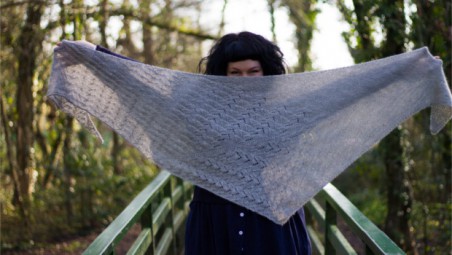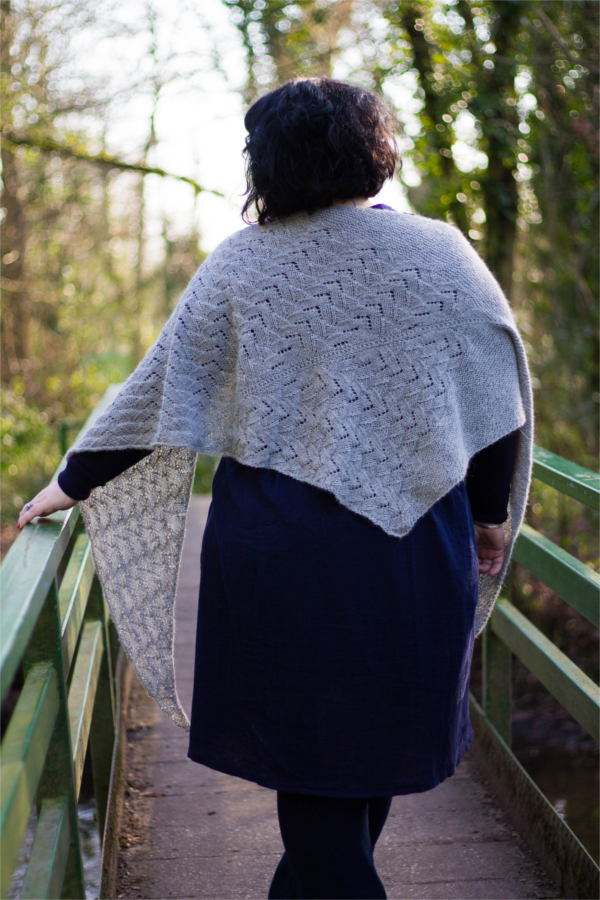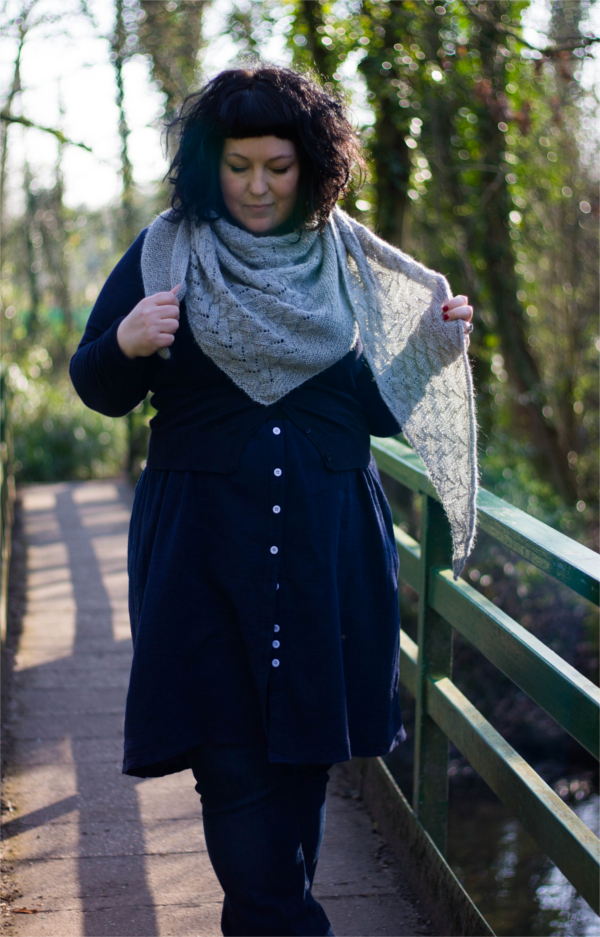Have you ever wondered what goes into designing a pattern? Knitting and crochet designer Anna Nikipirowicz stopped by to tell us her process!
Hand-knitting is truly a fascinating craft; it allows you to create an array of projects, anything from accessories to a garment and because you are in control of the fabric you produce you decide what color and fiber to use. If you are working from a pattern you can always adapt length or fit or just put your own mark on it to suit you and produce a one of a kind, unique item, so what do you need when you want to design a knitted item. There’s a lot of work and math that goes into designing a garment, as there are many elements to consider. However, I want to talk about the design process of an item of accessory. I design, knit and crochet lots of accessories as I LOVE them! Especially shawls- in fact, I’m rarely seen without one! To me they are a staple of any wardrobe, they cheer up an outfit instantly and they use a lot less yarn than a garment which means you can always treat yourself to few skeins of luxury.
So, what goes into designing a pattern?
There are few steps that need to be considered when planning a design and I would like to use my new shawl, Essie, as an example:
1: inspiration
2: sketch
- stitches: texture, lace, cables, colourwork
-yarn
3: swatch
4: pattern
5: get knitting
Inspiration
Where do you get inspiration? It is a question I get asked all the time and the truth is…. from everywhere. It could be the most random of things that will grab my attention and stay in my mind. Very often it would be the color of the yarn that will inspire me, this is what happened with Essie. When I saw the stunning range of color of the new Rooster Alpaca 4-ply yarn the silver color immediately stood out for me, it was just so elegant and so beautiful. It reminded me of some rather striking tiles I came across on an old building while on holiday in France. The beauty of the tiles was in the simplicity of their design, just triangles positioned on top of each other, creating almost a weave with a gray colored streak running across the length of the tile. Pinterest is also a wonderful tool for gathering ideas and creating mood boards. I did not have a picture of the tile to include in my mood board for Essie, however I still found plenty of useful ideas.
Sketch
So you have an idea, now you have to put it onto paper. It doesn’t matter if you can’t sketch, trust me I can’t either, I’m a lot better with a knitting needle or crochet hook than a pencil. It just needs to be a basic sketch of what you would like the finish item to look like. What shape do you want your shawl to be? How would you like it to be constructed? What design elements would you like it to have? When designing Essie, I wanted her to be a triangular shawl (one of my favorite shapes for a shawl), but not just standard top-down or bottom-up construction, something a little bit more interesting. I decided to give Essie an asymmetrical “spine” which echoes the gray colored streak in the tile and settled for tip to tip construction with increases and then decreases to form an unusually constructed triangular shape.
Stitches
This is to me always the most fun part! Choosing the stitches for your design. It is a good idea to invest in few stitch dictionaries, but first consider few things. What look do you want your design to have? Do you want it to have cables and little drape, lacy and open, or textured with medium drape or do you want to include some color work? Include all your stitch elements into your sketch.
There are few stitch categories and each one gives a different final look:
Textures: knit and purl combinations, best suited to medium to firm fabric to show the design to best advantage. Look gorgeous on shawls.
Cables: cables patterns are always narrower in width than stocking stitch or garter stitch as the fabric pulls when the cables are created, so this needs to be taken into account when creating.
Colourwork: Fair Isle produces narrower fabric because of stranding yarns at the back also very warm. Quite a dense fabric with little drape, perfect for cowls and scarfs in winter. This category also includes colored slip stitches which can produces striking effect.
Lace: Created by increasing and decreasing, produces very open and airy fabric, lace is perfect for shawls and wraps.
For Essie I decided to combine texture and lace and I tried to incorporate elements of the tile into the design. The shawl starts with a garter tip before moving onto the lace section which is formed of reverse stocking stitch triangles, in the same way as they were on the tile, I just added eyelet intervals.
Yarn
Now it’s time to choose yarn. There is a wide range of yarn to choose from, take time to decide what is going to suit your design best.
You need to pay attention to how the color of your yarn will work with your stitches. Variegated yarns are great for plain knits such as garter stitch or stocking stitch but cable or textured stitches will be lost, however they will look stunning in solid colors.
Also, be realistic about the use of your finished design, for example: choose machine-washable yarns for baby items, aran weight in winter and cottons in summer.
Swatch
There are four great reasons why knitting a swatch in your chosen stitch and yarn is crucial part of your design process.
1. To check tension/gauge
This is the stitch size you create when you knit, we all hold yarn and needle differently and this creates variations in tension.
The stitches and rows in your swatch will provide the basis for the mathematical calculations for your design.
2. To test your design
Knitting a swatch helps you test how the stitch will look and if your idea is translating into knitting. When designing a shawl I always do two swatches, one of the stitch and one of the shape of my design.
3. To test the fabric
Choosing the right needle size for your project will influence the quality of the fabric you produce.
You need to decide how you want the fabric to behave, do you want it quite open and airy or dense? Choose your needles to achieve the quality you would like.
4. To calculate the yarn amount
You need to know how much yarn you will need for your design and your swatch will help you with that, make sure you make a generous swatch, around 15 cm should be fine. If you are using few colors in your design, weight all the balls of yarn before and after you knit your swatch then just note down the difference in weight of each color. If you are making a design in one color just weight the swatch itself. Measure the number of stitches and rows per 10 cm precisely.
Pattern
Unless you are super organized at keeping notes as you knit, you can knit your design taking meticulous notes and write the pattern at the end. However, I do recommend to at least write the basic pattern for your design before you start knitting.
Firstly, think about what size do you want your finished design to be, with shawls I sometimes just knit until I think the shawl is large enough.
To get the size of your finished project:
Width: divide required width measurement by 10 cm, then multiply this figure by the stitch tension.
Length: divide the required length measurement by 10 cm, then multiply this figure by row tension.
For example: I want to knit a wrap which is 50 x 100 cm in double knitting yarn. The tension is 22 stitches and 30 rows to 10 cm.
Width: 50 cm divided by 10 cm = 5 - 5 multiply by 22 (stitch) = 110 stitches
Length: 100 cm divided by 10 cm = 10 - 10 multiplied by 30 = 300 rows
Therefore, I’ll need to cast on 105 stitches and knit for 300 rows.
Now you are ready to get knitting!
Till next time,
~Anna
To get Anna's gorgeous shawl pattern, click here.
To purchase the recommended yarn for her pattern, click here.






